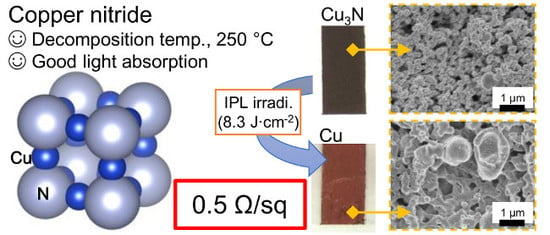Suitability of Copper Nitride as a Wiring Ink Sintered by Low-Energy Intense Pulsed Light Irradiation
Abstract
Share and Cite
Nakamura, T.; Cheong, H.J.; Takamura, M.; Yoshida, M.; Uemura, S. Suitability of Copper Nitride as a Wiring Ink Sintered by Low-Energy Intense Pulsed Light Irradiation. Nanomaterials 2018, 8, 617. https://doi.org/10.3390/nano8080617
Nakamura T, Cheong HJ, Takamura M, Yoshida M, Uemura S. Suitability of Copper Nitride as a Wiring Ink Sintered by Low-Energy Intense Pulsed Light Irradiation. Nanomaterials. 2018; 8(8):617. https://doi.org/10.3390/nano8080617
Chicago/Turabian StyleNakamura, Takashi, Hea Jeong Cheong, Masahiko Takamura, Manabu Yoshida, and Sei Uemura. 2018. "Suitability of Copper Nitride as a Wiring Ink Sintered by Low-Energy Intense Pulsed Light Irradiation" Nanomaterials 8, no. 8: 617. https://doi.org/10.3390/nano8080617
APA StyleNakamura, T., Cheong, H. J., Takamura, M., Yoshida, M., & Uemura, S. (2018). Suitability of Copper Nitride as a Wiring Ink Sintered by Low-Energy Intense Pulsed Light Irradiation. Nanomaterials, 8(8), 617. https://doi.org/10.3390/nano8080617





